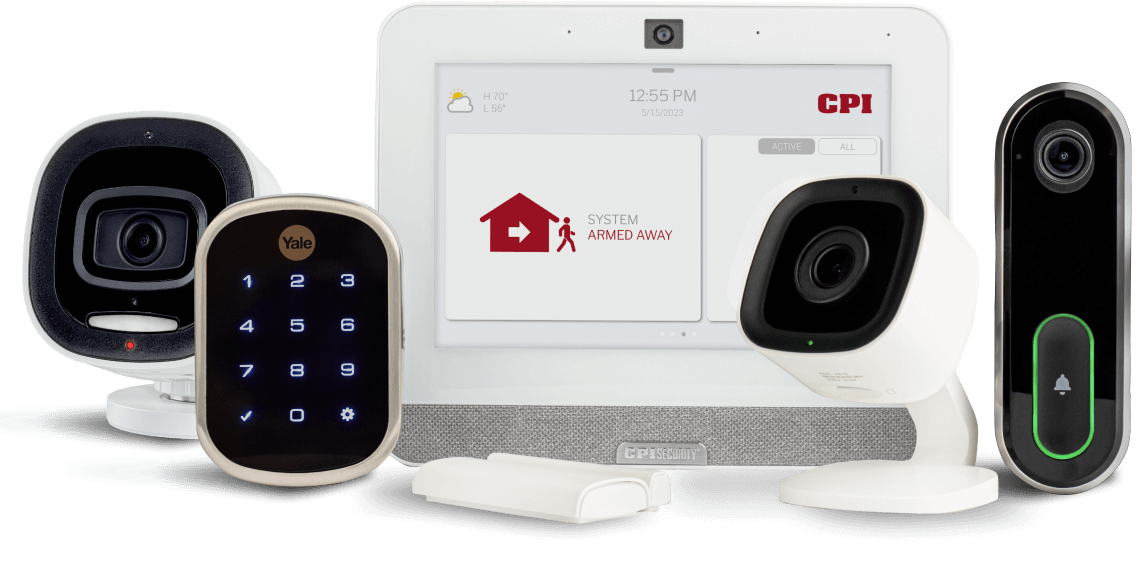As you surely know, moving into a new home is no simple task.
Taking care of a mountain of paperwork…
Purchasing new appliances and furniture for your new space…
Updating your address and account information in seemingly infinite places…
There is so much to do before you can ever feel fully settled in.
We’re in the business of more than just home security. Beyond protecting you, your family, home, and belongings, we take pride in the support and care that we provide our valued customers. With that mindset, we’ve compiled our favorite tips for packing along with this New Home Checklist below to hopefully ease some of the burdens of moving into your new home.
Moving Into a New House Checklist
- Do a thorough walk-through as soon as possible.
- Child-proof or pet-proof your new house if needed.
- Make a plan to unpack your house.
- Call your service providers to set up or transfer your utilities.
- Locate and test some of your home’s most important safety features.
- Clean your home before you move in.
- Deep clean appliances.
- Plan where your things will go.
- Prioritize needed repairs and updates.
- Refinish hardwoods or get new carpet or flooring.
- Consider cleaning your furniture.
- Replace your HVAC filter.
- Change all exterior locks.
- Install a home security system.
- Create a new house file or binder.
- Update your address.
- Meet your neighbors.
- Explore your new area.
1. Do a thorough walk-through as soon as possible.
As soon as you have keys to your new home, stop by to make sure that the house is in the condition you expect and that all the terms of the sale have been met. Check that all appliances that came with the house were actually left behind, the house is clean, and any agreed-upon repairs were completed.
2. Child-proof or pet-proof your new house if needed.
Go ahead and place outlet covers in the home’s outlets if you have small children. If your yard is fenced, walk the perimeter of the fence to make sure that there are no holes that a pet could escape through.
Look for any additional hazards that could be dangerous to your child or pet. If you don’t have time to check the entire house right away, make sure one area of the home is safe for your child or pet to play in and gate it off from the rest of your house.
3. Make a plan to unpack your house.
Consider what items you’ll need access to first and which rooms you think are most important for you to get in order. Then, create a prioritized list of how to unpack and organize your things in your new space.
4. Call your service providers to set up or transfer your utilities.
You’ll need electricity, water, and gas (if applicable) set up right away, and you’ll also want to set up your phone, internet, and cable service soon after.
5. Locate and test some of your home’s most important safety features.
Find your electrical panel and water shut-off valve so you know where they are in case of an emergency. Then, find and test all smoke detectors and carbon monoxide detectors.
If there are fire extinguishers in the home, locate them and check their expiration dates. If there aren’t any, add them to your list of things to purchase soon after moving in.
6. Clean your home before you move in.
The easiest time to clean your home is while it’s empty. Schedule a cleaning service to come clean things up before you move in or set aside some time for you to clean it yourself. You’ll want to scrub the bathrooms, clean windows and doors, wipe away any dust or dirt from the baseboards and trim, clean kitchen surfaces, and vacuum and mop the floors.
7. Deep clean appliances.
In addition to general house cleaning, you’ll also need to clean your appliances for maximum safety and efficiency.
Take some time to clean your refrigerator’s coils to help it run more efficiently. Then focus on removing any lint from your dryer duct for safety and faster drying. Clean your stove, dishwasher, washing machine and air conditioning unit as well.
8. Plan where your things will go.
Before your movers arrive with all of your things, aim to figure out a general idea of what furniture will go where. That way you can tell the movers exactly where to put it when they arrive, saving you time and potential backaches. You can bring a tape measure and even some graph paper with you when you do your walkthrough to help you map out your new home and figure out the best places for all your belongings.
9. Prioritize needed repairs and updates.
Begin creating a list of any repairs or updates your house needs, along with other home improvement projects like painting, so you can start to prioritize what work needs to happen before you begin to get settled.
10. Refinish hardwoods or get new carpet or flooring.
It’s much easier to update your flooring before you move in your furniture and other belongings than it is to do it later on.
11. Consider cleaning your furniture.
Moving is a great opportunity to clean any large furniture that you are bringing with you. Rent equipment to steam-clean your sofa and other upholstered furniture, and refresh your wooden furniture with mineral spirits.
12. Replace your HVAC filter.
Changing your air filters is a cheap, effective way to improve your home’s indoor air quality. If you suffer from allergies, you may want to hire a professional to clean your new home’s air ducts as well.
13. Change all exterior locks.
You’ll want to change your locks as soon as possible before you begin living in your new home, as you have no idea who may have a key to your house.
- Change the locks on each exterior door. Have the locksmith re-keyed to the same new key for simplicity. Get copies of the key made for each person who will be living in your home.
- If you have any smart locks or locks with keypads, be sure to change those codes right away. If you don’t have an existing keyless entry on one door, consider installing one, as it is a much safer alternative to hiding a key in case someone gets locked out.
14. Install a home security system.
Setting up a home security system is something else to do right away to keep you, your family, your home, and your belongings secure. At CPI Security, we can help you choose the right equipment and services to give you peace of mind and keep your new home secure from the very first night you spend in it.
Pro tip: If you’re an existing CPI customer, our Movers Program provides exclusive discounts and upgrades when you’re setting up security at your new home. Ask about our Movers Program and see how you qualify.
15. Create a new house file or binder.
Use this to store all paperwork related to your home, such as security system information, appliance warranties, paint colors, HOA covenants, and insurance information.
16. Update your address.
Anyone who regularly sends you mail will need your new address. Find a list of some people or companies who you likely need to update.
17. Meet your neighbors.
As you run into people in their yards or out and about exploring your community, take time to introduce yourself. Knowing your neighbors is a key part of settling into your new home, finding a sense of community, and even keeping your neighborhood safe when you or your neighbors go out of town.
18. Explore your new area.
Ask your neighbors for recommendations, use your trusted map app on your phone, or simply drive around to find places you’ll need to visit right away, such as grocery stores, drug stores, or hardware stores. At the same time, you can look for restaurants, parks, and other fun things to do and see in your new neighborhood.
Things To Buy For a New House
Once you move into your new home, you’ll likely find yourself visiting your local stores quite often as you discover new things you need to buy for your home. Here are some things you may need to buy for your new house right away.
- Exterior locks
- Fire extinguishers
- Child-proofing or pet-proofing supplies
- Living room, dining room, bedroom, and/or office furniture
- Rugs
- Lamps
- HVAC air filters
- Appliances that your home doesn’t already have them
What to Bring First When Moving Into a New House
If you referenced our moving out checklist when you packed up your old house, you should already have an “open first” box of all the things you’ll need right away, such as:
- Basic first aid supplies
- Cleaning supplies
- Toiletries and clothes for the first few days
- Snacks and ingredients for easy meals
- Basic tools
- Sheets, pillows, blankets, towels, and an air mattress if needed
- Paper and pens
- Phone chargers
- Toilet paper and paper towels
- Trash bags
- Scissors
List of Household Items Needed for a New Home
Whether you decide to pack them with your or purchase them once you move in, you’ll need the following items when you get to your new home.
- Paper products like toilet paper and paper towels
- Shower curtains and new shower liners
- Blinds or curtains
- Lamps for additional lighting
- Furniture
- Kitchen essentials
- Bedding
- Towels
- Basic tools
- Batteries
- Lightbulbs
- Cleaning supplies
What to Update When You Move
Finally, don’t forget that you’ll need to update your address with everyone who frequently sends you mail or packages. Begin by notifying the USPS—you can easily change your address and set up mail forwarding here.
You’ll also need to alert anyone else who has your old address and provide your updated one, such as:
- IRS
- DMV
- Social Security Office
- Utility companies (Electric, Water, Gas, Internet, Cable, etc.)
- Insurance companies (Home, car, etc.)
- Employer
- Banks and credit card companies
- Magazines subscriptions
- Streaming subscriptions
- Other subscriptions services
- Local board of elections
- Retail sites
- Doctor’s offices
Additionally, consider sending out a moving announcement to update your friends and family to provide them with your new address.
Moving In… Made Simple
Hopefully this blog has left you feeling a bit better prepared! The process can be daunting, but with the right planning, you can breeze through it and get to enjoying your new house from the start. If you’re in the process of selling your home or moving from your apartment, we wish you the best of luck getting packed and organized.
Remember that setting up home security at your new house should be among your top priorities. Not only will it keep you, your family, and your belongings safe during your transition, planning this step early will be more convenient for you and less stressful for your peace of mind. Add contacting CPI Security to your to-do list.
For more helpful tips on all things home security, safety, and smart innovation, learn more in the CPI Security blog.




